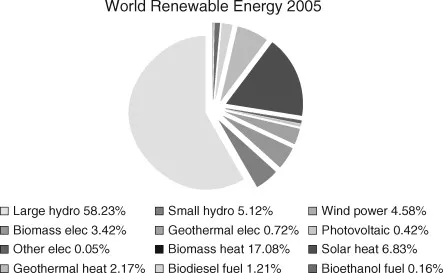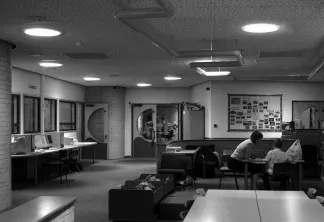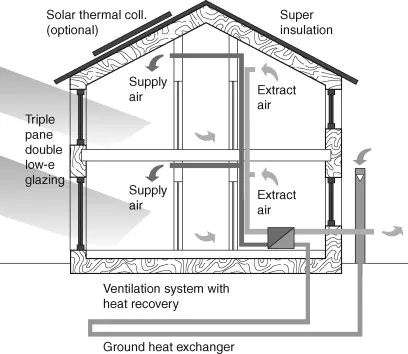![]()
Chapter 1. Introduction
Modern buildings need heat and electrical energy to perform their design functions. Even today, with climate change widely acknowledged as the greatest threat to human civilisation in its entire history, buildings are being designed and constructed which are, and will continue to be, totally dependent on national energy grids. These grids are still, and for a long time will continue to be, almost totally dependent on fossil fuels. Thanks to political inertia, vested interests and endemic nimbyism, it will almost certainly be several decades before large-scale wind, wave or tidal power make a majority contribution to the energy distributed through national grids.
Nuclear power – if it is to maintain or increase its current contribution – is also a long-term option, assuming uranium supplies continue to be available and the storage of radioactive waste is tolerated. Virtually all the potential sites for large-scale hydropower have already been exploited. In the meantime, therefore, Western industrialised nations are increasingly dependent on fossil fuel supplies from countries with different political agendas, conveyed through pipelines and along shipping routes difficult to protect against terrorist attack. ‘Peak oil’, the point at which global oil production will begin to decline as reserves dwindle, may be just around the corner – if it has not already arrived – and dwindling supplies and rocketing demand from India and China inevitably mean soaring prices for oil-based products and the energy generated from them.
For the moment and for the immediate and medium term future, energy consumption will equate fairly accurately with carbon dioxide emissions and the greenhouse effect that at the very least is exacerbating global warming and climate change. Buildings of all sizes and types account for about one-third of the energy consumption of modern industrial nations – and up to 60% of the electricity. Of a building's total carbon footprint, up to 50% of the energy consumed during its lifetime is accounted for by the materials used in its construction – this fraction will be inversely proportional to the efficiency of the building's insulation, dropping to around 25% for a poorly insulated structure. Motivation for serious attention to minimising a building's carbon footprint can be a sincere desire to mitigate the effects of climate change – or to insulate the building as far as is practicable from the uncertainties of energy supply from national grids. Achieving total independence from national energy grids is possible – at a price. (Some projects may not have access to such grids in the first place.) Achieving total independence from fossil fuels is also possible but harder, as most buildings not connected to grids depend on fossil-fuelled standby generators. (Such standby generators should also be classified as microgeneration installations.) Significant reductions in dependence on fossil fuels are now very possible, by combining a number of complementary strategies, of which the most visible, if not always the most effective, is microgeneration.
Figure Hydropower is still the biggest source of renewable energy
Generating heat and power at or close to the point of use is theoretically a more efficient use of available resources than centralised generation and the distribution of energy over long distances. Actually achieving efficiency on the micro scale is far from straightforward. A lot depends on the size and effectiveness of the energy store, without which solar and wind power in particular can never be cost effective (see Chapter 15). Retrofitted domestic scale solar water heating systems, for example, normally have only the existing hot water cylinder available as a thermal store, and consequently can never provide anything like all the domestic hot water needed throughout the year. New build homes could include larger thermal stores at ground level or in basements. However, as one moves higher up the building scale, into schools, hospitals, office blocks and the like, the numbers become more attractive. The effectiveness of thermal stores, wind turbines and biomass gasification plants, for example, increases rapidly with size. Several mature microgeneration technologies already exist, with hardware generally available, and others are moving on from the pilot plant stage. Designers now have real choice, and are able to select the technology – or combination of technologies – that will provide the most practical solution for any particular project. But before going down that route, there are two other strategies that must be deployed.
Achieving a low carbon sustainable building involves more than strapping a small wind turbine to the roof of an otherwise conventional building. This is tokenism, or ‘greenwashing’. True sustainability starts with serious consideration of the materials used in the construction of the building. Some materials have much greater embedded energy than others, either because of their method of manufacture or the distance they are transported to site, or the energy needed to handle and place them. Wood, for example, usually looks superior to concrete in this respect, although determining the exact ratio is more complex than it first might appear. Recycled materials are becoming more available and more predictable in performance, and new developments, such as low energy cements and biopolymers, are offering new options. And a material such as concrete may turn out to be desirable in the longer term because of its greater thermal mass. The whole subject is complex and is not covered here, but it should be high on the agenda for any building project aspiring to a low carbon footprint.
Figure Improved insulation is the first step (Courtesy of Passivhaus Institut)
Reducing the post-construction consumption of energy from fossil fuels starts with reducing the building's overall energy demand. Really significant reductions can be achieved by high levels of insulation, by the control of airflows in and out of the building, and by the management of solar gain. Low energy lighting coupled with light pipes to conduct natural light into dark corners, the choice of energy efficient appliances and equipment, and the installation of a sophisticated building management system, can help achieve energy demand reductions of 40% or more over conventional designs. A truly green building will also minimise its use of potable mains water, with both grey water and rainwater recycling systems.
Over recent years a number of design philosophies have emerged which all offer ways of attaining a low carbon footprint. One can be summarised as the ‘light and tight’ solution: developed extensively in Scandinavia, this features largely timber construction with high levels of insulation, high-performance windows, obsessive attention to sealing any potential air leakage through the building envelope and closely controlled ventilation with heat recovery from the outgoing air. In the opposite corner is the ‘mass and glass’ approach, which is based on a structure with high thermal mass and the intelligent use of solar gain through large windows.
Figure Microgeneration is no longer just for remote sites, like here in the Falklands (Courtesy of Proven Energy)
Overlying both these philosophies is the difference between the low and high technology solution. Low technology design features local materials and traditional techniques, such as adobe, green oak, windcatchers, biomass boilers, recycled insulation, solar water and air heating – and a high degree of human intervention in the building's day-to-day operation. A high technology solution may achieve much the same ends by the use of phase change materials as a thermal store, a biomass gasification plant feeding a trigeneration installation (see Chapters 11 and 15), a solar photovoltaic (PV) roofing membrane (see Chapter 4) or a unitised regenerative fuel cell. Or it could be said that the low technology approach is based on tried and tested principles backed up by well proven technology, while the alternative means taking something of a gamble on recently developed technologies which promise much higher performance at greater initial cost.
In moderate to high latitudes, climate change means that summertime cooling in the non-residential sector is becoming as important and beginning to consume as much energy as wintertime heating. Passive, low technology space cooling techniques have been around for millennia, but are not that easy to adapt to current building design preferences. Active cooling, on the other hand, need not necessarily mean conventional vapour compression air conditioning (see Chapters 13 and 15). Part of the problem, however, is the current attitude of building occupants. Over the last 50 years, habits and expectations have changed radically in the developed world. People expect to be comfortable in relatively skimpy clothing whatever the ambient conditions outside may be. This may well be changing, but in the short- to medium-term developers and designers have to look for ways to meet these expectations that allow the carbon footprint to be significantly reduced.
That is not to say that occupant expectations will continue to rise. Public awareness of the risks of global warming is close to the point where politicians and designers alike will have to take note. Gas-guzzling 4 × 4 ‘Chelsea tractors’ and strawberries from the other side of the world are becoming harder to justify. Doubts are being cast ever more loudly on the latest generation of energy-hungry consumer electronics, while low energy lighting and recycled paper are becoming the routine choice. There is a significant and increasing interest in alternative and renewable energy supplies, on the domestic scale at least. A market for truly low carbon buildings is growing amongst those who will accept some compromises on lifestyle. Commercial developers still doubt the willingness of potential tenants to pay for what is still perceived as a ‘green premium’ for a low carbon building, but local authorities and organisations with a green agenda are already demonstrating their appetite for the low carbon option.
Figure Intelligent use of light pipes can slash lighting costs (Courtesy of Monodraught)
Figure Light and tight – the Passivehaus approach (Courtesy of Passivhaus Institut)
This is despite the fact that some of the pioneering low carbon buildings have failed to live up to their developers’ and designers’ expectations. Natural ventilation, for example, can struggle to cope with cooking smells. Maintenance costs have often turned out to be much higher than expected, new technologies such as biomass gasification can run into unforeseen operational problems – and some technologies, such as small-scale wind, have simply failed to produce the energy predicted by their manufacturers. It has often been said that the most cost-effective low carbon technology for buildings is occupant behaviour modification. The argument goes that occupants should be persuaded to routinely switch off computers, printers, phone chargers and lighting when not in use. Also, by turning heating thermostats down a couple of degrees and turning cooling thermostats up a couple, there will be n...





